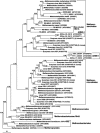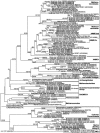Methanogen diversity evidenced by molecular characterization of methyl coenzyme M reductase A (mcrA) genes in hydrothermal sediments of the Guaymas Basin
- PMID: 16085853
- PMCID: PMC1183284
- DOI: 10.1128/AEM.71.8.4592-4601.2005
Methanogen diversity evidenced by molecular characterization of methyl coenzyme M reductase A (mcrA) genes in hydrothermal sediments of the Guaymas Basin
Abstract
The methanogenic community in hydrothermally active sediments of Guaymas Basin (Gulf of California, Mexico) was analyzed by PCR amplification, cloning, and sequencing of methyl coenzyme M reductase (mcrA) and 16S rRNA genes. Members of the Methanomicrobiales and Methanosarcinales dominated the mcrA and 16S rRNA clone libraries from the upper 15 cm of the sediments. Within the H2/CO2- and formate-utilizing family Methanomicrobiales, two mcrA and 16S rRNA lineages were closely affiliated with cultured species of the genera Methanoculleus and Methanocorpusculum. The most frequently recovered mcrA PCR amplicons within the Methanomicrobiales did not branch with any cultured genera. Within the nutritionally versatile family Methanosarcinales, one 16S rRNA amplicon and most of the mcrA PCR amplicons were affiliated with the obligately acetate utilizing species Methanosaeta concilii. The mcrA clone libraries also included phylotypes related to the methyl-disproportionating genus Methanococcoides. However, two mcrA and two 16S rRNA lineages within the Methanosarcinales were unrelated to any cultured genus. Overall, the clone libraries indicate a diversified methanogen community that uses H2/CO2, formate, acetate, and methylated substrates. Phylogenetic affiliations of mcrA and 16S rRNA clones with thermophilic and nonthermophilic cultured isolates indicate a mixed mesophilic and thermophilic methanogen community in the surficial Guaymas sediments.
Figures



References
-
- Albert, D. B., and C. S. Martens. 1997. Determination of low-molecular weight organic acid concentrations in seawater and pore-water samples via HPLC. Mar. Chem. 56:27-37.
-
- Bazylinski, D. A., J. W. Farrington, and H. W. Jannasch. 1988. Hydrocarbons in surface sediments from a Guaymas Basin hydrothermal vent site. Org. Geochem. 12:547-558.
-
- Boone, D. R., W. B. Whitman, and Y. Koga. 2001. Methanomicrobiales, p. 246-267. In D. R. Boone and R. W. Castenholz (ed.), Bergey's manual of systematic bacteriology, 2nd ed., vol. 1. The Archaea and the deeply branching and phototrophic bacteria. Springer, New York, N.Y.
-
- Boone, D. R., W. B. Whitman, and Y. Koga. 2001. Methanosarcinales ord. nov., p. 268-289. In D. R. Boone and R. W. Castenholz (ed.), Bergey's manual of systematic bacteriology, 2nd ed., vol. 1. The Archaea and the deeply branching and phototrophic bacteria. Springer, New York, N.Y.
-
- Boone, D. R., W. B. Whitman, and P. Rouvière. 1993. Diversity and taxonomy of methanogens, p. 35-80. In J. G. Ferry (ed.), Methanogenesis. Chapman and Hall, New York, N.Y.
Publication types
MeSH terms
Substances
Associated data
- Actions
- Actions
- Actions
- Actions
- Actions
- Actions
- Actions
- Actions
- Actions
- Actions
- Actions
- Actions
- Actions
- Actions
- Actions
- Actions
- Actions
- Actions
- Actions
- Actions
- Actions
- Actions
- Actions
- Actions
- Actions
- Actions
- Actions
- Actions
- Actions
- Actions
- Actions
- Actions
- Actions
- Actions
- Actions
LinkOut - more resources
Full Text Sources
Other Literature Sources
Molecular Biology Databases

